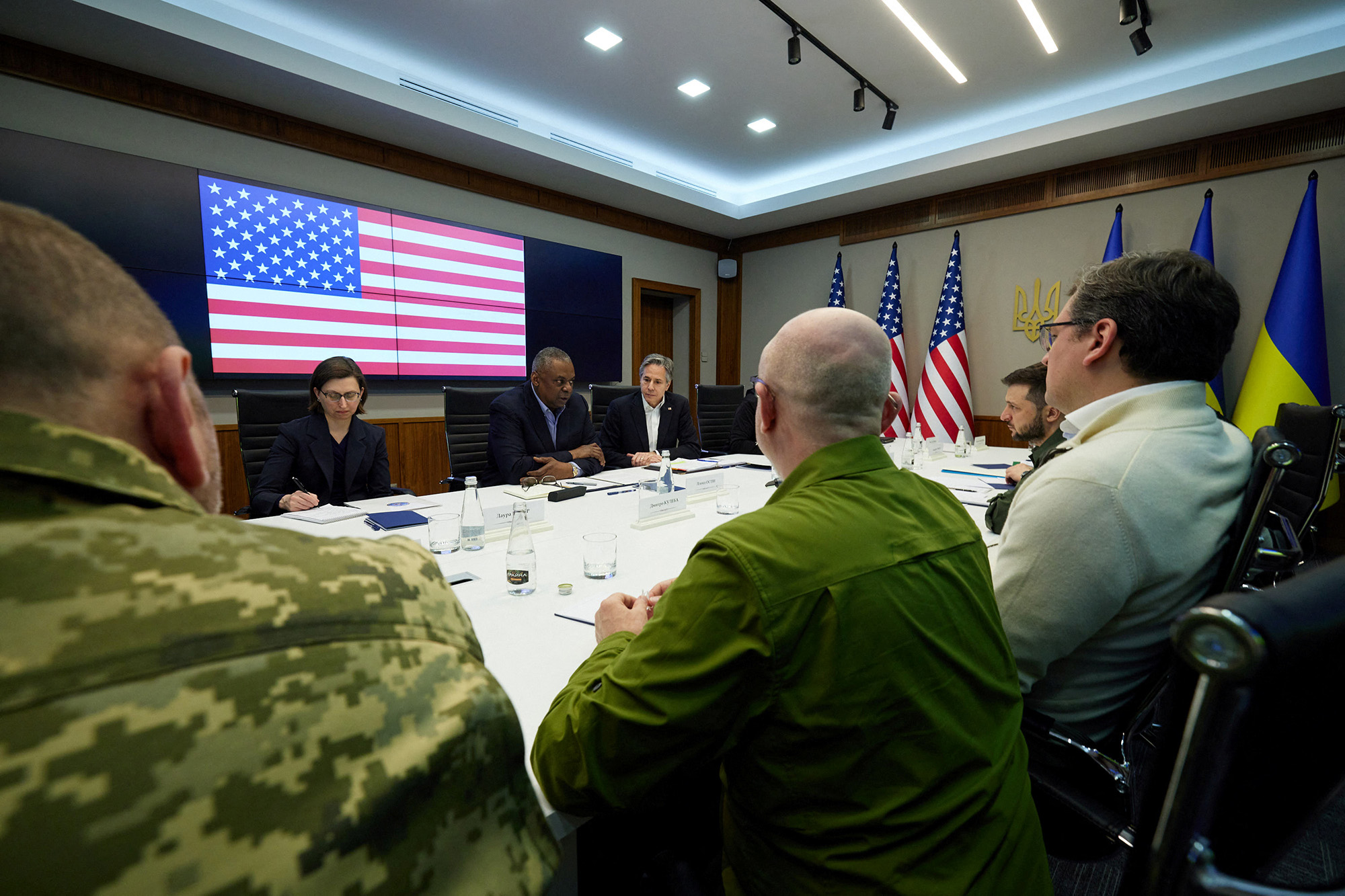
US Secretary of State Antony Blinken and Defense Secretary Lloyd Austin traveled to the Ukrainian capital of Kyiv on Sunday, where they met with President Volodymyr Zelensky and other Ukrainian officials, making them the highest-level US officials to have traveled to the country since Russia began its invasion.
Here are the key moments to come from this visit:
Blinken said US diplomats would return to Ukraine this week, a senior State Department official said, characterizing the move as a strong message of solidarity from the United States.
As part of the resumed US diplomatic presence in Ukraine, diplomats will "start with day trips into the Lviv" and "will graduate to potentially other parts of the country and ultimately, to resume presence in Kyiv," according to a senior State Department official.
Austin: "We want to see Russia weakened" While in Kyiv, Blinken and Austin also met with Foreign Minister Dmytro Kuleba, Defense Minister Oleksiy Reznikov and Interior Minister Denys Monastrysky for an extended, roughly 90-minute bilateral meeting, the senior State Department official said. The defense minister outline some of the United States' goals as the country continues to support Ukraine's efforts in the war.
"We want to see Russia weakened to the degree that it can't do the kinds of things that it has done in invading Ukraine," Austin said at a news conference at an undisclosed location in Poland near the Ukrainian border following the trip to Kyiv. "So it has already lost a lot of military capability. And a lot of its troops, quite frankly. And we want to see them not have the capability to very quickly reproduce that capability."
More aid to Ukraine Blinken and Austin discussed the Biden administration's intention to provide $713 million in additional foreign military financing to Ukraine and allied European and Balkan partners, according to the senior State Department official and a senior Defense Department official.
US President Joe Biden on Monday announced that he will nominate Bridget Brink as US ambassador to Ukraine. The post that has been without a confirmed ambassador since Marie Yovanovitch was recalled in May 2019. Brink is the current US ambassador to Slovakia.
Blinken and Austin's visit came as the first tranche of about 50 Ukrainians will complete artillery training in a country outside Ukraine, the defense official said. Another tranche of about 50 Ukrainians will also begin training soon, a defense official said.
Zelensky's office issued a readout of the meeting on Monday, stressing the importance of the US officials' visit and saying the country "counts on the support of our partners."
Officials reiterate no involvement by US forces In a background briefing, the State and Defense officials made clear that the US military would still not be involved directly in the war.
In the Monday press briefing, Austin said the US believes Ukraine can win the war against Russia with "the right equipment and the right support."
Will Biden visit? While officials hailed the trip as a testament to the US commitment to Ukraine, they have also faced questions about why Biden did not make the trip himself.
"The President of the United States is somewhat singular, in terms of what travel would require. So it goes well beyond what a Cabinet secretary would or what virtually any other world leader would require," the State Department official noted.
UK Prime Minister Boris Johnson visited the country earlier this month. Top officials from the EU and the Baltics have also visited Zelensky in Kyiv.
What's a land bridge? Here's what Putin is trying to do in Ukraine
From CNN's Ben Morse
Russia last week revealed that the goal of its invasion of Ukraine was to take "full control" over the southern part of the country as well as the eastern Donbas region — an aim that if achieved, would enable it to create a land corridor through Ukrainian territory connecting the Russian region of Rostov with Crimea, the peninsula it annexed in 2014, and beyond.
Maj. Gen. Rustam Minnekaev, the acting commander of Russia's Central Military District, was quoted by TASS, a Russian state news agency, as saying Friday that the goal was to create a land corridor between Ukraine's eastern Donbas region and Crimea.
Speaking at the annual general meeting of the Union of Defense Industry Enterprises of the Sverdlovsk region, he added that control over Ukraine's south would potentially give Russian forces access to Transnistria, a separatist statelet in Moldova, where a contingent of Russian forces has been stationed since the early 1990s.
As the second phase of Russia's invasion continues, Russian forces that were originally deployed to the north of Ukraine, after taking heavy losses, have been redeployed — along with fresh troops — and are now piling into Ukraine from the northeast, with Russian military officials claiming that their strategic goals had shifted to taking all of the eastern Donbas region.
Russian forces at present have only partial control of southern Ukraine, with the Ukrainian government still in control of the key cities of Mykolaiv and Odesa and some Ukrainian forces holding out in the Azovstal steel factory in the encircled port of Mariupol.
In 2018, Russia opened a 19-kilometer bridge (more than 5 miles) over the Kerch Strait, linking its Krasnodar region by road with the Crimean peninsula it annexed in 2014. But a land corridor would mean Russian controls a huge swath of Ukrainian territory linking up with Crimea.
"If Russia scores a win in Mariupol and gains a land bridge, it will have secured control of more than 400 kilometers (or 249 miles) of the Black Sea coast since the start of the war and denied Ukraine access to 80 percent of its previous coastline, further destroying its economy," an analysis in Foreign Policy said last week.

30_j.jpg)

31_j.jpg)





.jpg)
.jpg)
Gumercrafts Social Media